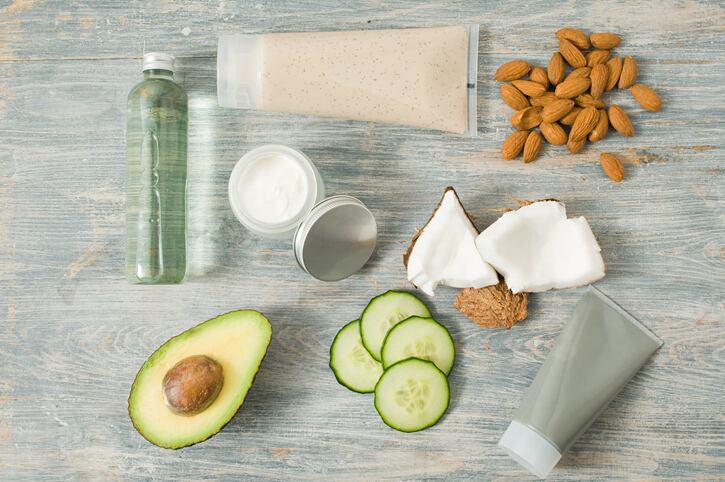In response to the rising cost of cosmetics and personal beauty care products, according to a recent NielsenIQ survey, almost one in four (24%) BPC shoppers plan to spend less, 47% plan to spend the same, and 29% plan to spend more this year. Of the shoppers who plan to spend more, 30% plan to upgrade their product purchases to a more environmentally sustainable option.
Considering the high value consumers place on sustainable product options when making purchasing decisions, there is substantial incentive for cosmetics and personal beauty product manufacturers to incorporate clean beauty messaging into their branding and marketing strategies. In addition to clearly marked labelling, ingredients transparency is one of the most effective options for companies to best communicate their sustainability to consumers.
CosmeticsDesign spoke with Brenda Georgina Rechy, Project Manager for Ingredient Traceability, Sage Hartlaub, Sustainability Manager, and Prerna Chatterjee, Senior Sustainability Manager at BASF, to learn more about how the European multinational is investing in ingredients transparency as a means better connecting with consumers of cosmetics and personal beauty care products.
CDU: How does ingredient transparency fit into the larger framework of the clean beauty movement within the cosmetics and personal beauty care industries?
BASF: Clean Beauty has revolutionized the industry and introduced a new set of consumer priorities. Consumers are demanding information about the products they apply on their skin and hair.
In a 2022 Mintel survey of US consumers, 82% of respondents report using more clean beauty products compared to last year. In this same study, the top attributes associated with clean beauty were Natural/organic (63%), Eco-friendly (54%), Non-toxic ingredients (51%) and free from certain ingredients (49%).
Consumers want to make sure their ingredients are clean and that the brands they buy from align with their values. They care about high quality ingredients, and they care about how those ingredients are made. Here is where Transparency comes into play.
CDU: In what way or ways is BASF working to better establish ingredients transparency within its product lines?
BASF: One of our key tools to enable ingredient transparency is our Ingredient Insider tool. This allows formulators to view and filter our products according to various industry relevant clean beauty lists and formulate their products accordingly.
Beyond just the ingredients, we care about having transparent supply chains. Real sustainability begins at the source and carries through along the entire value chain.
We have been working for years to drive sustainable and transparent sourcing within our palm supply chain through our membership with RSPO [Roundtable on Sustainable Palm Oil, a global non-profit organization working across the supply chain to implement standards for palm tree oil sustainability] and our work in the RSPO working group Trade & Traceability. Through this work, we have achieved traceability for almost 96% of our overall oil palm exposure back to oil mill level.
However, we also know there is more work to do. That’s why in 2021, BASF signed up for the Palmoil.io web platform to track deforestation from plantations and link it to its suppliers. Palmoil.io brings together the critical ingredients for effective forest monitoring - forest alerts, high resolution satellite scenes, supplier relationships, and grievance information, along with an estimated traceability to plantation approach.
And going one step further, in 2022 we launched a digital blockchain technology that allows End-to-end Traceability, which creates transparency on environmental and social impacts and promotes ethical sourcing.
CDU: Can you tell us more about the BASF project working to establish complete traceability of the end-to-end supply chain?
BASF: There is a strong connection between transparency, traceability, and trust. This trust has suffered recently, with 73% of US consumers believing Eco-friendly claims have become a marketing gimmick for beauty brands, according to 2022 data from Mintel. Ingredient transparency and sustainability can help to rebuild this trust, with 30% of US consumers reporting that having strong sustainability initiatives in place would help to build their trust in a beauty/personal care brand.
Eco-conscious consumers are beginning to demand the traceability of raw materials and more transparency from brands. This project ultimately makes it possible for end consumers to know exactly where their favorite personal care products come from, taking them to the exact tree of origin using fully digitized and secure blockchain technology.
All the sustainable practices carried on through the entire supply chain are proven and are tamper-free, meaning that all the claims and sustainable practices throughout the supply chain can be verified and once uploaded in the blockchain they cannot be tampered with or modified. Ultimately, this type of tool helps us to have proof of responsible sourcing, to demonstrate that you really do what you say you do.
We have taken things to the next level and empowered our customers with this technology, as it enables a connection between end consumers and farmers. Imagine being able to tip the farmer of your coffee as well as the barista!
CDU: What are some of the best ways for a brand to communicate their commitment to environmental sustainability and ingredient transparency to consumers?
BASF: When talking about sustainable formulations, it is important to properly communicate why they are sustainable and what their advantages are.
This is connected to Consumer education; consumers are curious and as an industry we want to educate and avoid misinformation. This is a team effort, between brands, suppliers and diverse associations.
As a company with a wide portfolio of ingredients for personal care, it is important that we are able to support our customers by providing reliable and valuable safety and sustainability data for our ingredients, be it through clinical testing, product carbon footprints, COSMOS approval, and more. These help both our customers and the end consumers have confidence in the sustainability of their products.
Additionally, I would consider sharing is key. Share best practices, share what brands are already doing but also share their challenges. As an ingredient supplier, our job is to enable our customers to meet their sustainability goals, and ultimately to deliver those sustainability benefits to the consumer. None of that is possible without the coordination and cooperation between ingredient suppliers and product manufacturers to respond to what the consumers wants.
CDU: How does ingredient traceability potentially impact the decision-making process for manufacturers and suppliers to the cosmetics and personal care industries when formulating new products (or reformulating existing products)?
BASF: Consumers are looking at brands with a 360-degree view, taking into consideration many aspects around its sustainability credentials, and the activities behind. It is important that this drive for transparency and traceability continues along the entire value chain.
BASF actively promotes sustainability in the supply chain with ambitious targets: by 2025, we aim to have conducted sustainability evaluations for 90% of the BASF Group’s relevant spend. In 2022, 85% of the relevant spend had been evaluated. Of the suppliers re-evaluated in 2022, 76% had improved their sustainability performance.
We also make the decision to work with certified supply chains wherever possible. In cases like palm, in addition to the work mentioned above, Palmoil.io also produces monthly Risk Insight reports. Insights are published in a concise report that BASF sends to suppliers for further information and potential action plans to stop deforestation and to keep compliance with BASF’s forest protection policy.
In supply chains where certification schemes do not exist, we have helped to develop them. We were a founding member of Project Pragati, the world’s first sustainable castor bean program.
Further, the project has established the unified sustainability code SuCCESS (Sustainable Castor Caring for Environmental and Social Standards) that sets a standard for certified sustainable castor oil – the first code on the global market. In this way, we are not only using sustainability in our own decision making, but also bringing new offerings to our customers for their own decision making.
CDU: Are there any increased costs to the manufacturer or supplier when establishing ingredients traceability for a cosmetic or personal beauty care product? (e.g. needing to reformulate or source more expensive ingredients that adhere to clean beauty principles?)
BASF: Innovation will always require additional resources, but we believe this is worth it to be able to deliver on more sustainable products. For example, we worked to calculate the cradle-to-gate PCFs for our 45,000 sales products, which required significant information gathering from both our own operations as well as our suppliers.
Our responsible sourcing initiatives require input from everyone along the value chain, from the finished goods manufacturer to the farmers themselves. We believe that sustainability and ingredient transparency and traceability is a shared responsibility, where everyone must be willing to do their part.
Today we are beginning to see a rise in Traceability and Transparency throughout various industries, but to ensure sustainable production this level of traceability must become the standard.





